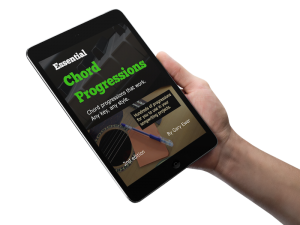Last week I received an email from a blog reader, with a question regarding chord progressions. It’s similar to one that I receive a lot, and so I thought perhaps I would post it here, along with my answer [slightly edited in spots for clarity], and hope that it might be helpful for those of you who are trying to create interesting, effective chords for your songs.
To set this up, the question regards the concept of strong versus fragile progressions. A strong progression is one that strongly indicates the song’s key, with no ambiguity (I-IV-V-I, for example). A fragile one is a progression that is pleasantly ambiguous in some way.
Q- I have a question about something that has remained unclear to me for a while, and I hope you can help. You talk about Strong and Fragile progressions a lot. For example, in one of your blog posts you mention that the progression of C to F (I-IV) is very “strong.” This makes sense. However, it seems like you only talk about Strong/Fragile progressions in regards to DIATONIC chords. Does the same Strong/Fragile logic apply to a non-diatonic progressions (like I-iv-minor)? Or, I believe C to Em (I-iii) is considered “fragile”–would a move from C to Eb (I-bIII) fall into this “fragile” category? These are just a few examples obviously, but I hope you see where I’m going with this. Any thoughts?
A- Thanks for writing. The concept of fragile vs strong is a spectrum, which is to say that a progression can be “a little” or “a lot” fragile or strong, and then anything in between. That’s a useful way of thinking of progressions particularly in the pop genres, because most pop songs feature strong progressions, whether they’re verse or chorus progressions. Though most progressions are strong, pop songs typically feature verse progressions that have a small measure of “fragility” (i.e., mostly strong), then switching to a progression in the chorus that is very strong.
 Just need some chord progressions to get your next song started? “Essential Chord Progressions” and “More Essential Chord Progressions” gives you pages of them! Get them along with the other manuals in “The Essential Secrets of Songwriting” 10-eBook Bundle.
Just need some chord progressions to get your next song started? “Essential Chord Progressions” and “More Essential Chord Progressions” gives you pages of them! Get them along with the other manuals in “The Essential Secrets of Songwriting” 10-eBook Bundle.
When it comes to what actually constitutes a fragile progression, it’s best to ask this question: Does the progression strongly indicate a key, with no ambiguity, or is it in some way vague about key?
So I-IV (C-F) is very strong, because it starts with a tonic chord, and moves to the subdominant chord. The key is very clear, and there is nothing about those two chords that puts the key in doubt, [especially when heard in context]. But if you play I-iv (C-Fm), there is a small amount of ambiguity because Fm doesn’t belong to C major. So for a short moment, the listener might be temporarily confused about the key: Is this a progression in the key of F minor, where the C chord is the V-chord? Or is this a progression in C major, where the F chord is a so-called modal mixture? (By the way, this ambiguity is not at all undesirable. In fact, tonally-vague progressions are usually the most beautiful ones we create for our songs.)
Added to this issue is the length of the progression. It’s possible for progressions to start off fragile, turn to being something stronger, and then end in a tonally-strong way. In those cases, you could look at the entire progression and make a judgement (if you need to) about how strong or fragile the entire progression is.
Think of it this way: Let’s say you were a painter, and you painted random abstract shapes on the canvas using primarily red and green. You could look at any one corner of the canvas and say, “right here, it’s mainly green.” On another part of the canvas, you might say, “right here, it’s mainly red.” When you look at the entire canvas, you might say, “I see how the colours change as I look from left to right on the canvas, but on the whole, I think the canvas is mainly red.”
In practical usage, the concept of fragile vs strong will go a long way to describing the kinds of progressions you see in most pop music genres. Just keep in mind that because most audiences want some kind of immediate understanding of the music, most progressions in the chorus will be very strong (I-IV-V-I kinds of progressions), and the verse progressions will be mostly strong, with just a hint of tonal vagueness so that it doesn’t get too weird for the genre. (Maybe I-bVII-IV-ii-bIII-IV-I, for example).
 Written by Gary Ewer. Follow Gary on Twitter.
Written by Gary Ewer. Follow Gary on Twitter.
 “The Essential Secrets of Songwriting” 10-eBook Bundle contains several eBooks meant to help you with your chord progressions. Whether it’s lists of chords you need, or you want to understand the nuts and bolts so that you can create your own powerful ones, check out the Bundle today.
“The Essential Secrets of Songwriting” 10-eBook Bundle contains several eBooks meant to help you with your chord progressions. Whether it’s lists of chords you need, or you want to understand the nuts and bolts so that you can create your own powerful ones, check out the Bundle today.











Interesting piece!–I interview established songwriters in Melbourne, may bring this up with them!
Pingback: Chord Progressions, and the Strong-Fragile Concept - The Hit Songwriting Formula | The Hit Songwriting Formula